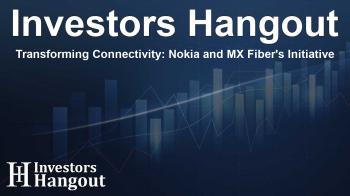Transforming Connectivity: Nokia and MX Fiber's Initiative

Nokia and MX Fiber Join Forces for Enhanced Connectivity
Nokia and MX Fiber have announced an ambitious project to enhance digital connectivity in Southeast Mexico, focusing on regions that traditionally lack robust internet infrastructure. This collaboration aims to provide high-capacity access and promote economic development through advanced technologies.
Expanding the Digital Infrastructure
Strategic Developments
The deployment includes seven new Dense Wavelength Division Multiplexing (DWDM) routes, which play a critical role in supporting key infrastructure initiatives, such as the Interoceanic Corridor and the Maya Train. These projects are not just transportation initiatives; they are essential components of a broader vision for economic revitalization in the region, stimulating growth and enhancing access to essential services.
High-Capacity Network Solutions
Nokia's optical backbone solution, the 1830 Photonic Service Switch (PSS), underlines this partnership's commitment to advanced technology. This robust infrastructure supports a range of services from 10G to 400G, ensuring that network capacity can scale effectively to meet the growing demands of customers.
Empowering Communities with Enhanced Connectivity
Critical Benefits for Users
Communities in Chiapas, Tabasco, and Quintana Roo, along with upcoming expansions into Campeche and Veracruz, stand to benefit significantly from the enhanced connectivity. Residents and businesses will experience faster internet speeds and improved access to cloud services and applications, fostering an environment ripe for innovation and economic growth.
Scalability and Future-Proofing
With MX Fiber's initiative, the network expansion spans an impressive 1,800 kilometers. Utilizing the latest Flex-Grid DWDM technology, this high-capacity network enables seamless service delivery and scalability, ensuring that upgrades to 400G and even 800G are achievable without service interruptions. Such features empower businesses and communities with reliable and adaptable connectivity.
Supporting Economic Initiatives
Collaboration for Community Growth
Nestor Bergero, CEO of MX Fiber, expressed his enthusiasm for the collaboration, emphasizing that the optical solutions provided by Nokia significantly lower operational costs while delivering high-quality services. This is crucial for the success of major projects designed to enhance economic opportunities in the region.
Vision for Digital Inclusion
Javier Falcón, Director of Network Infrastructure for Latin America at Nokia, highlighted the importance of this project in promoting digital inclusion and economic empowerment. By providing state-of-the-art optical technology, they are ensuring that Southeastern Mexico can grow sustainably and included in the global digital economy.
Innovative Technologies Shaping the Future
Pioneering Network Solutions
Nokia stands at the forefront of technological innovation, developing networks that not only meet today's demands but also anticipate future needs. Their commitment to open architectures and high-performance networks allows them to adapt seamlessly to various ecosystems, creating opportunities for monetization and scalability that benefit a broad range of clients.
Your Connections Are Our Priority
With an emphasis on security, reliability, and sustainability, Nokia is driving forward with solutions that empower service providers, enterprises, and partners globally. This collaboration is more than just about connectivity - it represents a commitment to building a connected world that acts as one.
Frequently Asked Questions
What is the main goal of the Nokia and MX Fiber collaboration?
The collaboration aims to enhance digital connectivity in Southeast Mexico by deploying a high-capacity optical network, promoting economic growth and digital inclusion.
How will the optical network benefit local communities?
Local communities will experience faster internet speeds, improved cloud access, and support for data-intensive applications, which are essential for modern business and living standards.
What technology supports the new optical network?
The optical network is supported by Nokia's 1830 Photonic Service Switch (PSS) and Flex-Grid DWDM technology, enabling scalable service options ranging from 10G to 400G.
Which regions are set to benefit from this project?
Regions including Chiapas, Tabasco, Quintana Roo, and prospective expansions into Campeche and Veracruz will benefit from the new connectivity infrastructure.
Who can be contacted for media inquiries regarding this project?
Media inquiries can be directed to the Nokia Press Office via email at Press.Services@nokia.com.
About The Author
Contact Owen Jenkins privately here. Or send an email with ATTN: Owen Jenkins as the subject to contact@investorshangout.com.
About Investors Hangout
Investors Hangout is a leading online stock forum for financial discussion and learning, offering a wide range of free tools and resources. It draws in traders of all levels, who exchange market knowledge, investigate trading tactics, and keep an eye on industry developments in real time. Featuring financial articles, stock message boards, quotes, charts, company profiles, and live news updates. Through cooperative learning and a wealth of informational resources, it helps users from novices creating their first portfolios to experts honing their techniques. Join Investors Hangout today: https://investorshangout.com/
The content of this article is based on factual, publicly available information and does not represent legal, financial, or investment advice. Investors Hangout does not offer financial advice, and the author is not a licensed financial advisor. Consult a qualified advisor before making any financial or investment decisions based on this article. This article should not be considered advice to purchase, sell, or hold any securities or other investments. If any of the material provided here is inaccurate, please contact us for corrections.

